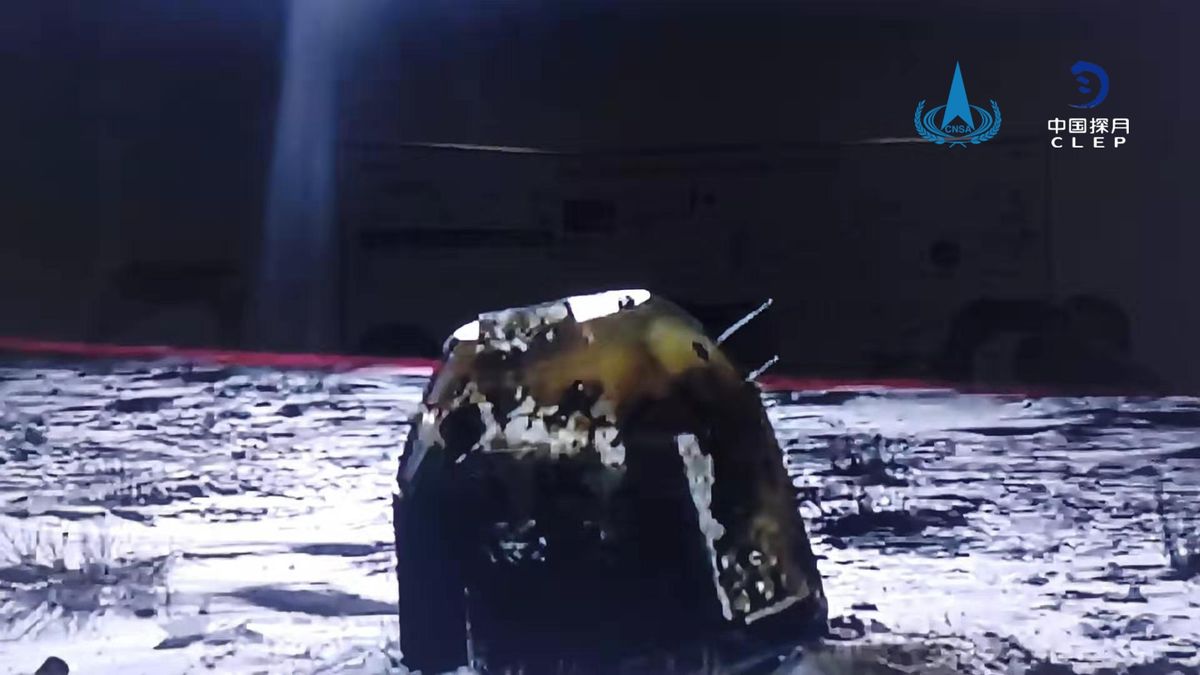
The Chang'e 5 return capsule carrying lunar samples is headed for a Beijing laboratory for opening, with a research team eagerly awaiting their chance to start studying the fresh moon specimens.
Given the success of the lunar exploration mission, China space officials say a next step is to cooperate with scientists of other nations to analyze the moon samples.
China is set to establish a lunar sample-analysis solicitation, with a team of domestic and foreign scientists organized to consider requests for the samples.
China on the moon! A history of Chinese lunar missions in pictures
Zhang Kejian, head of the China National Space Administration (CNSA), declared Chang'e 5 a success. The mission wrapped up China's current three-step lunar exploration program of orbiting, landing and bringing back samples, which began in 2004, Chinese space officials said.
"Now that the Chang'e 5 probe's returner has come back with samples of lunar soil, an important step next is that we will carry out extensive cooperation with scientists of other countries in carrying out in-depth studies of the lunar soil," Zhang said in a China Central Television (CCTV) interview.
Chang'e 5 laid a foundation for China's future crewed lunar and deep-space exploration efforts, which will include the construction of a research base on the moon, if all goes according to plan.
"We hope to cooperate with other countries to build the international lunar scientific research station, which could provide a shared platform for lunar scientific exploration and technological experiments," said Pei Zhaoyu, deputy director of CNSA's Lunar Exploration and Space Program Center, according to CCTV.
Search and recovery teams
On Wednesday (Dec. 16), the return capsule separated from the Chang'e 5 orbiter/returner craft under ground control while high above the Atlantic Ocean, according to the CNSA. The capsule entered Earth's atmosphere and, after aerodynamic deceleration, skipped back out again. The capsule then re-entered to perform a second aerodynamic deceleration.
The capsule's parachute opened at about 6 miles (10 kilometers) above the ground, and the craft came down in a predetermined area in Inner Mongolia. Search and recovery teams found it in short order.
An air team in helicopters spotted the capsule using infrared cameras, while a ground team followed in SUVs to reach the snow-covered landing site. Ground teams cordoned off the area, confirmed the touchdown coordinates and set up a communication station to connect with the Beijing Aerospace Flight Control Center.
"We have just measured the shape of the crater that the returner landed on, which is part of the scientific data collection. Then the returner will [put on a] 'new warm coat' to prevent the remaining propellant inside from being frozen during the transportation to Zhurihe Airport, where the propellant will be expelled from [the] returner," said Cao Ruiqiang, a space product assurance assistant, in a CCTV interview.
The Chang'e 5 capsule was loaded onto a truck and then transported by helicopter and airplane to Beijing.
Related: We may be in a 'golden age' of sample-return space missions
Lunar lab
Chang'e 5 was designed to bring back 4.4 lbs. (2 kilograms) of lunar samples. The mission consisted of four modules — an orbiter, a lander, an ascender and a returner.
The multi-phase mission launched on Nov. 23. On Dec. 1, its lander-ascender combination touched down north of Mons Rümker in Oceanus Procellarum, also known as the Ocean of Storms, on the near side of the moon.
In Beijing, CNSA will transfer the lunar materials to the Lunar Sample Laboratory at the National Astronomical Observatory (NAO) under the Chinese Academy of Sciences, a facility that has been built specially for storage, processing and analysis of the samples.
"The biggest challenge is unsealing in the atmosphere the sample package, which is sealed in a vacuum environment [on the moon]," said Zhang Guangliang, chief designer of the Ground Application System of Chinese Lunar Exploration Project's third phase, in a CCTV interview. "To address that, we have verified several times and designed a special process. We will unpack the samples in a vacuum environment, and transfer them to a nitrogen environment for storage and processing."
Analysis methods
"The first thing we consider is to use some damage-free analysis methods as much as possible, such as observation of optical characteristics under a microscope, and spectral measurement in the laboratory," said Zhou Qin, also identified as a chief designer of the Ground Application System of Chinese Lunar Exploration Project's third phase, in a CCTV interview.
"Of course, these measurements will be conducted and analyzed under a special environment such as with high-purity nitrogen, so as to minimize the impact of the Earth's environment on lunar samples," Zhou said. "In addition, we will also do some chemical composition analysis, which will cause damage. We will make analysis comprehensively, and try to obtain more useful information with the smallest sample amount."
You can view newly released videos focused on the Chang'e 5 return capsule here, here and here.
Leonard David is author of the recently released book, "Moon Rush: The New Space Race" published by National Geographic in May 2019. A longtime writer for Space.com, David has been reporting on the space industry for more than five decades. Follow us on Twitter @Spacedotcom and on Facebook. This version of the story published on Space.com.
Article From & Read More ( China's Chang'e 5 moon samples are headed to the lab - Space.com )https://ift.tt/3p7Mydc
Science
No comments:
Post a Comment